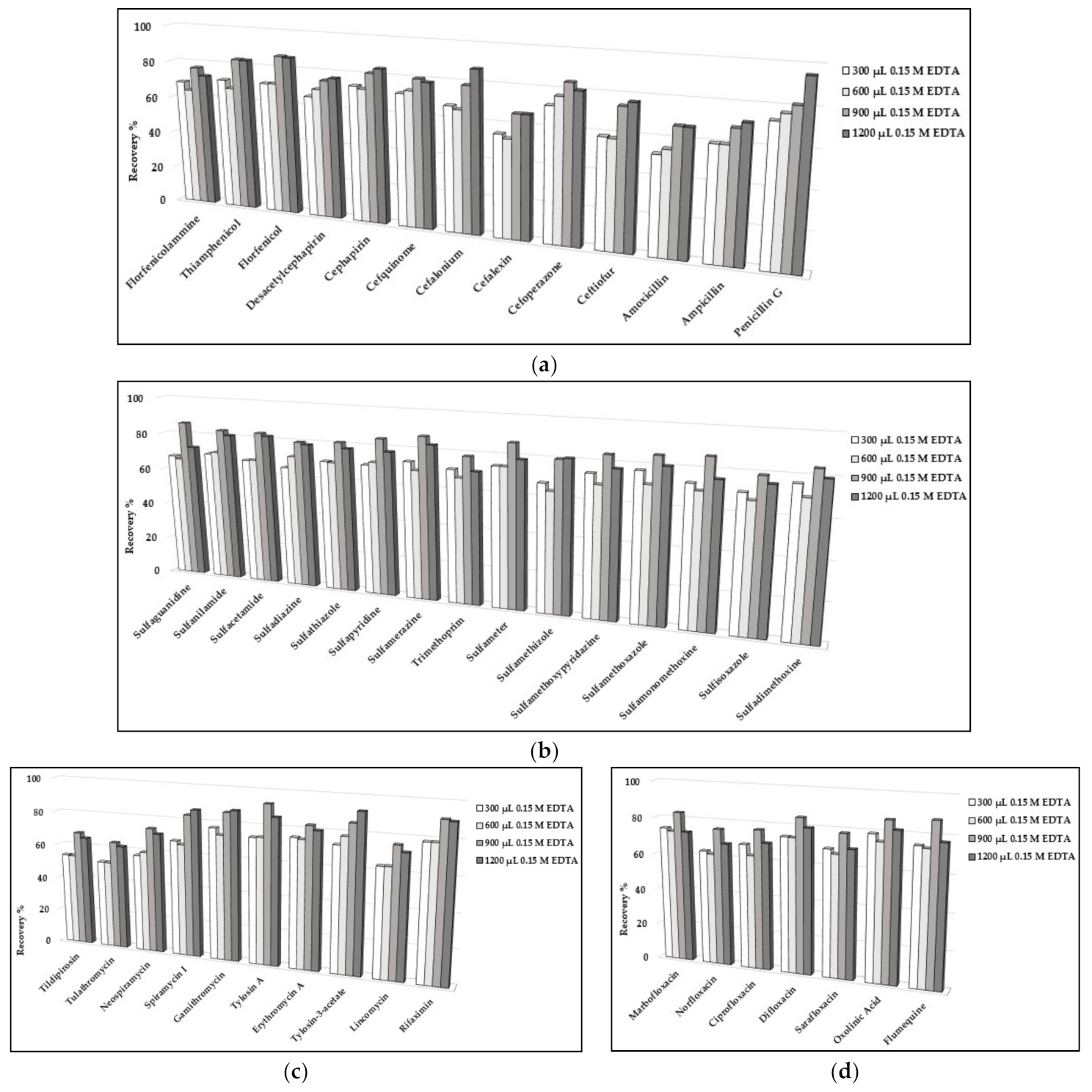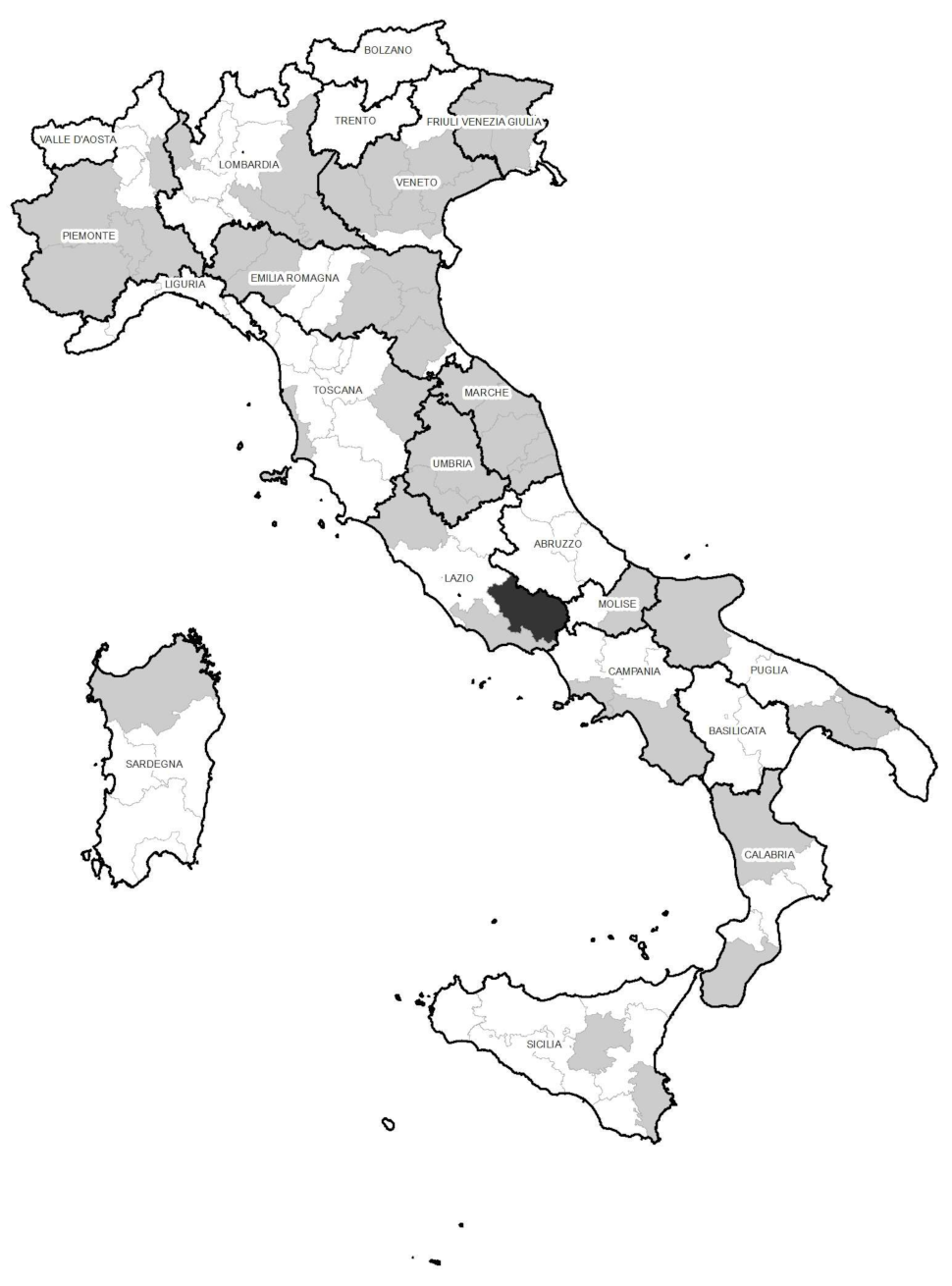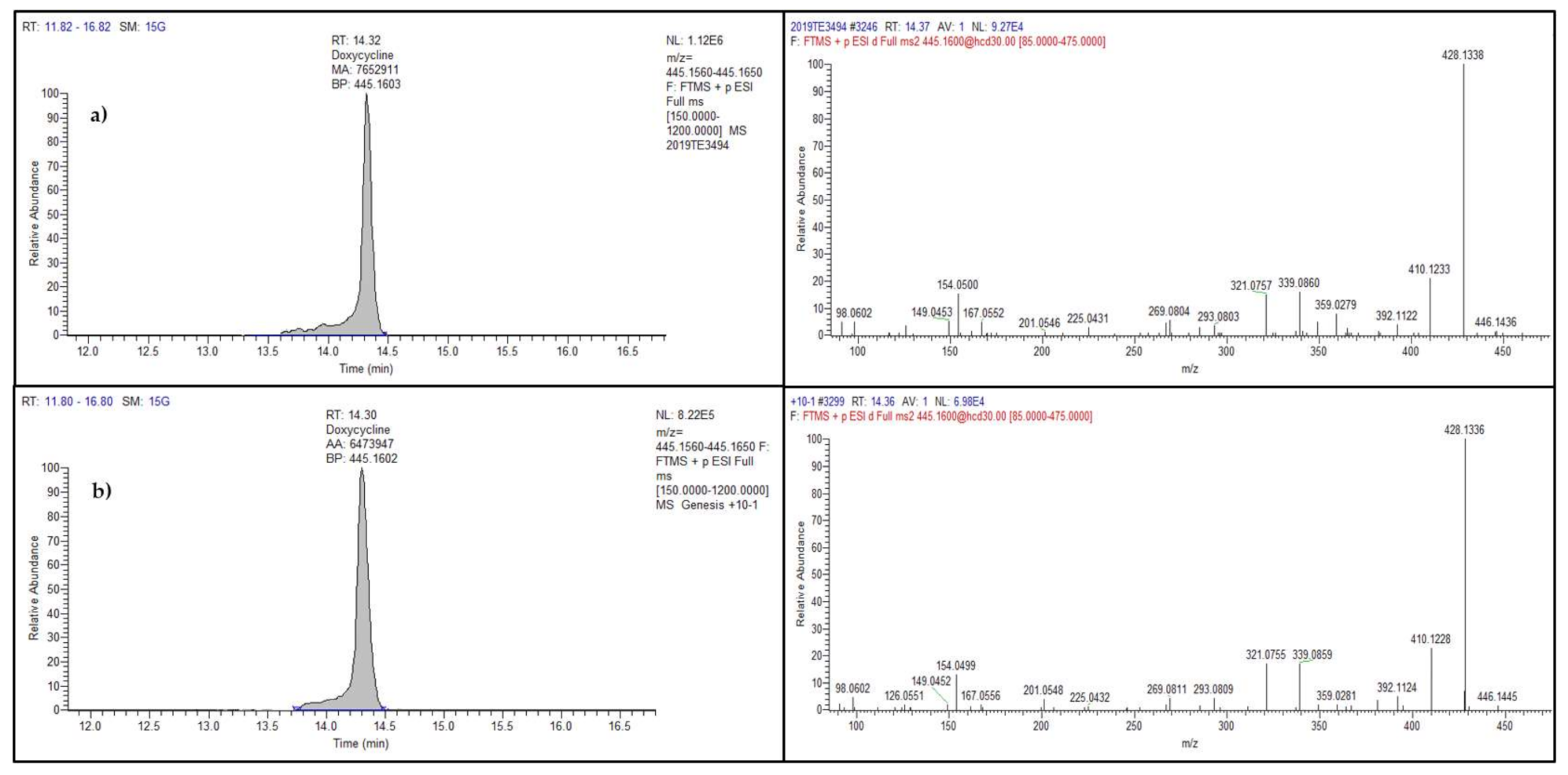Survey on Antibiotic Residues in Egg Samples in Italy
Abstract
:1. Introduction
2. Materials and Methods
2.1. Chemicals, Reagents, Stock, and Intermediate Solutions
2.2. Chromatographic Conditions
2.3. MS Conditions
2.4. Sample Preparation
2.5. Method Validation
2.6. Real Samples Analysis
2.7. Risk Exposure
3. Results and Discussion
3.1. Sample Preparation
3.2. Method Validation
3.3. Real Samples Analysis
3.4. Risk Exposure
4. Conclusions
Supplementary Materials
Author Contributions
Funding
Acknowledgments
Conflicts of Interest
References
- Gao, J.; Cui, Y.; Tao, Y.; Huang, L.; Peng, D.; Xie, S.; Wang, X.; Liu, Z.; Chen, D.; Yuan, Z. Multiclass method for the quantification of 92 veterinary antimicrobial drugs in livestock excreta, wastewater, and surface water by liquid chromatography with tandem mass spectrometry. J. Sep. Sci. 2016, 39, 4086–4095. [Google Scholar] [CrossRef]
- European Medicines Agency. Sales of veterinary antimicrobial agents in 31 European countries in 2017: Trends from 2010–2017, Ninth ESVAC Rep. EMA/294674/2019. (2019) 106. Available online: https://www.ema.europa.eu/en/documents/report/sales-veterinary-antimicrobial-agents-31-european-countries-2017_en.pdf (accessed on 9 July 2021).
- EFSA; European Centre for Disease Prevention and Control (ECDC). The European Union Summary Report on Antimicrobial Resistance in Zoonotic and Indicator Bacteria from Humans, Animals and Food in 2017/2018; Wiley-Blackwell Publishing Ltd.: Hoboken, NJ, USA, 2020. [Google Scholar] [CrossRef] [Green Version]
- European Commission. REGULATION (EU) No 37/2010 on Pharmacologically Active Substances and Their Classification Regarding Maximum Residue Limits in Foodstuffs of Animal Origin (Text with EEA Relevance); European Commission: Brussels, Belgium, 2009. [Google Scholar]
- Paoletti, F.; Sdogati, S.; Barola, C.; Giusepponi, D.; Moretti, S.; Galarini, R. Development and validation of a multiclass confirmatory method for the determination of over 60 antibiotics in eggs using liquid-chromatography high-resolution mass spectrometry. Food Control 2021, 127, 108109. [Google Scholar] [CrossRef]
- Capriotti, A.L.; Cavaliere, C.; Piovesana, S.; Samperi, R.; Laganà, A. Multiclass screening method based on solvent extraction and liquid chromatography–tandem mass spectrometry for the determination of antimicrobials and mycotoxins in egg. J. Chromatogr. A 2012, 1268, 84–90. [Google Scholar] [CrossRef]
- Wang, J.; Fan, X.; Liu, Y.; Du, Z.; Feng, Y.; Jia, L.; Zhang, J. Extraction optimization of sixteen cephalosporins in milk by filtered solid phase extraction and ultra high pressure liquid chromatography coupled to tandem mass spectrometry. Anal. Methods 2017, 9, 1282–1289. [Google Scholar] [CrossRef]
- Yamaguchi, T.; Okihashi, M.; Harada, K.; Konishi, Y.; Uchida, K.; Do, M.H.N.; Bui, L.T.; Nguyen, T.D.; Phan, H.B.; Bui, H.D.T.; et al. Detection of antibiotics in chicken eggs obtained from supermarkets in Ho Chi Minh City, Vietnam. J. Environ. Sci. Health Part B 2017, 52, 430–433. [Google Scholar] [CrossRef]
- Zhou, J.; Xu, J.-J.; Cong, J.-M.; Cai, Z.-X.; Zhang, J.-S.; Wang, J.-L.; Ren, Y.-P. Optimization for quick, easy, cheap, effective, rugged and safe extraction of mycotoxins and veterinary drugs by response surface methodology for application to egg and milk. J. Chromatogr. A 2018, 1532, 20–29. [Google Scholar] [CrossRef] [PubMed]
- Xu, X.; Xu, X.; Han, M.; Qiu, S.; Hou, X. Development of a modified QuEChERS method based on magnetic multiwalled carbon nanotubes for the simultaneous determination of veterinary drugs, pesticides and mycotoxins in eggs by UPLC-MS/MS. Food Chem. 2019, 276, 419–426. [Google Scholar] [CrossRef]
- Hou, X.; Xu, X.; Xu, X.; Han, M.; Qiu, S. Application of a multiclass screening method for veterinary drugs and pesticides using HPLC-QTOF-MS in egg samples. Food Chem. 2020, 309, 125746. [Google Scholar] [CrossRef]
- Yang, Y.; Qiu, W.; Li, Y.; Liu, L. Antibiotic residues in poultry food in Fujian Province of China. Food Addit. Contam. Part B 2020, 13, 177–184. [Google Scholar] [CrossRef]
- Hu, M.; Ben, Y.; Wong, M.H.; Zheng, C. Trace Analysis of Multiclass Antibiotics in Food Products by Liquid Chromatography-Tandem Mass Spectrometry: Method Development. J. Agric. Food Chem. 2021, 69, 1656–1666. [Google Scholar] [CrossRef]
- Leclercq, C.; Arcella, D.; Piccinelli, R.; Sette, S.; Le Donne, C.; Turrini, A. The Italian National Food Consumption Survey INRAN-SCAI 2005–06: Main results in terms of food consumption. Public Health Nutr. 2009, 12, 2504–2532. [Google Scholar] [CrossRef] [Green Version]
- Sette, S.; Le Donne, C.; Piccinelli, R.; Arcella, D.; Turrini, A.; Leclercq, C. The third Italian National Food Consumption Survey, INRAN-SCAI 2005–06—Part 1: Nutrient intakes in Italy. Nutr. Metab. Cardiovasc. Dis. 2011, 21, 922–932. [Google Scholar] [CrossRef] [PubMed]
- Sette, S.; Le Donne, C.; Piccinelli, R.; Mistura, L.; Ferrari, M.; Leclercq, C. The third National Food Consumption Survey, INRAN-SCAI 2005–06: Major dietary sources of nutrients in Italy. Int. J. Food Sci. Nutr. 2013, 64, 1014–1021. [Google Scholar] [CrossRef] [PubMed]
- Moretti, S.; Dusi, G.; Giusepponi, D.; Pellicciotti, S.; Rossi, R.; Saluti, G.; Cruciani, G.; Galarini, R. Screening and confirmatory method for multiclass determination of 62 antibiotics in meat. J. Chromatogr. A 2016, 1429, 175–188. [Google Scholar] [CrossRef] [PubMed]
- Desmarchelier, A.; Feuerrigel, P.; Ahmed, H.F.; Moulin, J.; Beck, A.; Mujahid, C.; Bessaire, T.; Savoy, M.-C.; Mottier, P. Stability study of veterinary drugs in standard solutions for LC-MS/MS screening in food. Food Addit. Contam. Part A 2018, 35, 696–706. [Google Scholar] [CrossRef]
- Jang, J.-W.; Lee, K.-S.; Kwon, K.; Bae, S.-C.; Kim, H.S. Simultaneous determination of thirteen quinolones in livestock and fishery products using ultra performance LC with electrospray ionization tandem mass spectrometry. Food Sci. Biotechnol. 2013, 22, 1–9. [Google Scholar] [CrossRef]
- 96/23/EC Commission Decision, 96/23/EC COMMISSION DECISION of 12 August 2002 Implementing Council Directive 96/23/EC Concerning the Performance of Analytical Methods and the Interpretation of Results (Notified under Document Number C(2002) 3044)(Text with EEA Relevance) (2002/657/EC), 96/23/EC Commission Decision. (2002) 29. Available online: https://eur-lex.europa.eu/LexUriServ/LexUriServ.do?uri=OJ:L:2002:221:0008:0036:EN:PDF (accessed on 9 April 2021).
- European Commission. Analytical Quality Control and Method Validation for Pesticide Residues Analysis in Food and Feed (SANTE/12682/2019), Sante/12682/2019. (2019) 1–48. Available online: https://www.eurl-pesticides.eu/userfiles/file/EurlALL/AqcGuidance_SANTE_2019_12682.pdf (accessed on 9 April 2021).
- Wang, C.; Li, X.; Yu, F.; Wang, Y.; Ye, D.; Hu, X.; Zhou, L.; Du, J.; Xia, X. Multi-class analysis of veterinary drugs in eggs using dispersive-solid phase extraction and ultra-high performance liquid chromatography-tandem mass spectrometry. Food Chem. 2021, 334, 127598. [Google Scholar] [CrossRef]
- EMEA. Summary of the Scientific Discussion for the Establishment of MRLs. European Agency for the Evaluation of Medicinal Products Committee for Veterinary Medicinal Products, 44 (2015) 1–7. Available online: http://www.ema.europa.eu/docs/en_GB/document_library/Maximum_Residue_Limits_-_Report/2015/02/WC500183123.pdf (accessed on 9 July 2021).
- Khaled, A.; Belinato, J.R.; Pawliszyn, J. Rapid and high-throughput screening of multi-residue pharmaceutical drugs in bovine tissue using solid phase microextraction and direct analysis in real time-tandem mass spectrometry (SPME-DART-MS/MS). Talanta 2020, 217, 121095. [Google Scholar] [CrossRef]
- Khaled, A.; Gómez-Ríos, G.A.; Pawliszyn, J. Optimization of Coated Blade Spray for Rapid Screening and Quantitation of 105 Veterinary Drugs in Biological Tissue Samples. Anal. Chem. 2020, 92, 5937–5943. [Google Scholar] [CrossRef]
- Galarini, R.; Moretti, S.; Saluti, G. Quality Assurance and Validation General Considerations and Trends. In Chromatographic Analysis of the Environment: Mass Spectrometry Based Approaches, 4th ed.; CRC Press: Boca Raton, FL, USA, 2017; p. 45. Available online: https://www.taylorfrancis.com/books/9781315316208/chapters/10.1201/9781315316208-10 (accessed on 10 July 2019).
- UNI CEI EN ISO/IEC 17025:2018, (n.d.). Available online: http://store.uni.com/catalogo/uni-cei-en-iso-iec-17025-2018?josso_back_to=http://store.uni.com/josso-security-check.php&josso_cmd=login_optional&josso_partnerapp_host=store.uni.com (accessed on 23 August 2021).
- Banche Dati—Accredia—Laboratori di Prova, (n.d.). Available online: https://services.accredia.it/accredia_labsearch.jsp?ID_LINK=293&area=7&numeroaccr=0111&classification=A&isRestricted=false&dipartimento=L (accessed on 23 August 2021).
- European Food Safety Authority. Report for 2018 on the results from the monitoring of veterinary medicinal product residues and other substances in live animals and animal products. EFSA Support. Publ. 2020, 17. [Google Scholar] [CrossRef]
- European Food Safety Authority. Report for 2019 on the results from the monitoring of veterinary medicinal product residues and other substances in live animals and animal products. EFSA Support. Publ. 2021, 18. [Google Scholar] [CrossRef]



| Analyte | Class | Mean Recovery (%) | CVr (%) | CVwR (%) | CCα (µg kg−1) | LOD (µg kg−1) | LOQ (µg kg−1) | ME a (%) |
|---|---|---|---|---|---|---|---|---|
| Florfenicol amine | Amphenicols | 74 | 9.0 | 9.8 | 3.3 | 3.3 | 3.3 | 3 |
| Thiamphenicol b | 77 | 8.9 | 11 | 10 | 3.3 | 10 | −9 | |
| Florfenicol b | 80 | 8.1 | 11 | 10 | 3.3 | 10 | −17 | |
| Desacetyl cephapirin | Cephalosporins | 74 | 8.6 | 9.7 | 3.3 | 3.3 | 3.3 | −5 |
| Caphapirin | 77 | 7.5 | 9.5 | 3.3 | 3.3 | 3.3 | −2 | |
| Cefquinome | 76 | 7.5 | 9.7 | 3.3 | 3.3 | 3.3 | 11 | |
| Cefacetrile | 76 | 8.9 | 11 | 3.3 | 3.3 | 3.3 | −28 | |
| Cefalonium | 75 | 6.8 | 8.8 | 3.3 | 3.3 | 3.3 | −9 | |
| Cefalexin | 64 | 9.8 | 13 | 3.3 | 3.3 | 3.3 | 1 | |
| Cefazolin b | 75 | 7.7 | 9.5 | 10 | 3.3 | 10 | 12 | |
| Cefoperazone | 78 | 8.7 | 10 | 3.3 | 3.3 | 3.3 | −12 | |
| Ceftiofur | 67 | 9.0 | 13 | 3.3 | 3.3 | 3.3 | −13 | |
| Trimethoprim | Diaminopyrimidines | 77 | 9.8 | 11 | 3.3 | 3.3 | 3.3 | −7 |
| Lincomycin | Lincosamides | 73 | 9.2 | 11 | 59 | 3.3 | 3.3 | −12 |
| Pirlimycin | 60 | 14 | 14 | 3.3 | 3.3 | 3.3 | −11 | |
| Tildipirosin | Macrolides | 63 | 8.3 | 11 | 3.3 | 3.3 | 3.3 | −2 |
| Tulatromycin marker (CP 60,300) | 66 | 7.6 | 10 | 3.3 | 3.3 | 3.3 | −5 | |
| Tulathromycin A b | 62 | 8.3 | 9.6 | 3.3 | 3.3 | 10 | −4 | |
| Neospiramycin | 68 | 8.4 | 13 | 3.3 | 3.3 | 3.3 | −14 | |
| Spiramycin I | 75 | 8.7 | 11 | 3.3 | 3.3 | 3.3 | −10 | |
| Gamitromycin | 74 | 14 | 15 | 3.3 | 3.3 | 3.3 | −8 | |
| Tilmicosin | 77 | 11 | 13 | 3.3 | 3.3 | 3.3 | −6 | |
| Tylosin A | 82 | 10 | 13 | 242 | 3.3 | 3.3 | −10 | |
| Erythromycin A | 80 | 7.3 | 10 | 175 | 3.3 | 3.3 | −12 | |
| Tylosin-3-acetate | 85 | 11 | 13 | 244 | 3.3 | 3.3 | −4 | |
| Tylvalosin | 90 | 9.5 | 14 | 245 | 3.3 | 3.3 | 17 | |
| Amoxicillin | Penicillins | 65 | 8.2 | 11 | 3.3 | 3.3 | 3.3 | −5 |
| Ampicillin | 69 | 7.8 | 9.7 | 3.3 | 3.3 | 3.3 | 1 | |
| Penicillin G | 77 | 9.9 | 13 | 3.3 | 3.3 | 3.3 | −9 | |
| Oxacillin | 77 | 8.8 | 9.8 | 3.3 | 3.3 | 3.3 | −9 | |
| Penicillin V | 76 | 9.1 | 10 | 29 | 3.3 | 3.3 | −7 | |
| Cloxacillin | 75 | 10 | 11 | 3.3 | 3.3 | 3.3 | −8 | |
| Dicloxacillin | 74 | 9.1 | 11 | 3.3 | 3.3 | 3.3 | −18 | |
| Nafcillin | 76 | 9.9 | 10 | 3.3 | 3.3 | 3.3 | −9 | |
| Tiamulin | Pleuromutilins | 79 | 10 | 12 | 1199 | 3.3 | 3.3 | −18 |
| Valnemulin | 76 | 9.8 | 15 | 3.3 | 3.3 | 3.3 | −40 | |
| Marbofloxacin | Quinolones | 80 | 10 | 13 | 3.3 | 3.3 | 3.3 | −13 |
| Norfloxacin | 69 | 7.4 | 13 | 3.3 | 3.3 | 3.3 | −12 | |
| Enrofloxacin | 81 | 8.0 | 7.2 | 3.3 | 3.3 | 3.3 | −7 | |
| Ciprofloxacin | 70 | 7.3 | 13 | 3.3 | 3.3 | 3.3 | −9 | |
| Danofloxacin | 76 | 8.8 | 12 | 3.3 | 3.3 | 3.3 | 10 | |
| Difloxacin | 81 | 9.4 | 11 | 3.3 | 3.3 | 3.3 | −2 | |
| Sarafloxacin | 75 | 8.9 | 12 | 3.3 | 3.3 | 3.3 | −7 | |
| Oxolinic acid | 82 | 8.6 | 11 | 3.3 | 3.3 | 3.3 | −13 | |
| Nalidixic acid | 81 | 8.4 | 11 | 3.3 | 3.3 | 3.3 | −5 | |
| Flumequine | 82 | 9.1 | 10 | 3.3 | 3.3 | 3.3 | −23 | |
| Rifaximin | Rifamycins | 84 | 7.9 | 13 | 3.3 | 3.3 | 3.3 | 6 |
| Sulfaguanidine | Sulfonamides | 76 | 8.8 | 12 | 3.3 | 3.3 | 3.3 | 20 |
| Sulfanilamide | 76 | 8.3 | 11 | 3.3 | 3.3 | 3.3 | −7 | |
| Sulfacetamide b | 76 | 7.3 | 8.1 | 10 | 3.3 | 10 | −1 | |
| Sulfadiazine | 78 | 8.1 | 10 | 3.3 | 3.3 | 3.3 | 8 | |
| Sulfathiazole | 78 | 7.8 | 9.2 | 3.3 | 3.3 | 3.3 | −9 | |
| Sulfapyridine | 79 | 8.1 | 9.3 | 3.3 | 3.3 | 3.3 | −5 | |
| Sulfamerazine b | 76 | 9.0 | 9.9 | 10 | 3.3 | 10 | 22 | |
| Sulfamoxole | 76 | 7.9 | 11 | 3.3 | 3.3 | 3.3 | −12 | |
| Sulfameter | 83 | 9.3 | 9.7 | 3.3 | 3.3 | 3.3 | −12 | |
| Sulfamethizole | 78 | 8.4 | 10 | 3.3 | 3.3 | 3.3 | −3 | |
| Sulfamethazine | 80 | 9.4 | 12 | 3.3 | 3.3 | 3.3 | −3 | |
| Sulfamethoxypyridazine | 78 | 9.8 | 12 | 3.3 | 3.3 | 3.3 | −6 | |
| Sulfachloropyridazine | 78 | 9.1 | 11 | 3.3 | 3.3 | 3.3 | −1 | |
| Sulfamethoxazole | 81 | 8.6 | 10 | 3.3 | 3.3 | 3.3 | −14 | |
| Sulfamonomethoxine | 80 | 9.2 | 11 | 3.3 | 3.3 | 3.3 | −3 | |
| Sulfadoxin | 80 | 8.6 | 11 | 3.3 | 3.3 | 3.3 | −12 | |
| Sulfisoxazole | 79 | 8.1 | 11 | 3.3 | 3.3 | 3.3 | −2 | |
| Sulfadimethoxine | 81 | 7.9 | 9.9 | 3.3 | 3.3 | 3.3 | −22 | |
| Sulfaquinoxaline | 80 | 7.7 | 10 | 3.3 | 3.3 | 3.3 | −25 | |
| 4-Epitetracycline | Tetracyclines | 68 | 7.7 | 9.2 | 230 | 3.3 | 3.3 | −5 |
| 4-Epioxytetracycline | 64 | 7.1 | 9.0 | 230 | 3.3 | 3.3 | 3 | |
| Tetracycline | 72 | 8.0 | 11 | 235 | 3.3 | 3.3 | −1 | |
| Oxytetracycline | 68 | 6.9 | 10 | 234 | 3.3 | 3.3 | 4 | |
| 4-Epichlortetracycline | 67 | 6.8 | 11 | 236 | 3.3 | 3.3 | 18 | |
| Chlortetracycline | 73 | 6.3 | 10 | 233 | 3.3 | 3.3 | 16 | |
| Doxycycline | 69 | 9.5 | 13 | 3.3 | 3.3 | 3.3 | −12 |
| Detected Analyte | Detected Concentration (μg kg−1) | MRL (μg kg−1) | ADI (μg kg−1 b.w.) | ADI % (Mean) | ADI % (99th) | ||||||||||||||
|---|---|---|---|---|---|---|---|---|---|---|---|---|---|---|---|---|---|---|---|
| Infants | Children | Teenagers | Adults | Elderly | Infants | Children | Teenagers | Adults | Elderly | ||||||||||
| M | F | M | F | M | F | M | F | M | F | M | F | ||||||||
| Doxycycline | 22 | Not fixed | 3 | 0.4 | 0.6 | 0.3 | 0.3 | 0.2 | 0.2 | 0.2 | 0.2 | 2.9 | 3.6 | 1.5 | 1.7 | 1.2 | 1.1 | 1.1 | 0.8 |
Publisher’s Note: MDPI stays neutral with regard to jurisdictional claims in published maps and institutional affiliations. |
© 2021 by the authors. Licensee MDPI, Basel, Switzerland. This article is an open access article distributed under the terms and conditions of the Creative Commons Attribution (CC BY) license (https://creativecommons.org/licenses/by/4.0/).
Share and Cite
Saluti, G.; Colagrande, M.N.; Castellani, F.; Ricci, M.; Diletti, G.; Scortichini, G. Survey on Antibiotic Residues in Egg Samples in Italy. Separations 2021, 8, 148. https://doi.org/10.3390/separations8090148
Saluti G, Colagrande MN, Castellani F, Ricci M, Diletti G, Scortichini G. Survey on Antibiotic Residues in Egg Samples in Italy. Separations. 2021; 8(9):148. https://doi.org/10.3390/separations8090148
Chicago/Turabian StyleSaluti, Giorgio, Maria Novella Colagrande, Federica Castellani, Matteo Ricci, Gianfranco Diletti, and Giampiero Scortichini. 2021. "Survey on Antibiotic Residues in Egg Samples in Italy" Separations 8, no. 9: 148. https://doi.org/10.3390/separations8090148
APA StyleSaluti, G., Colagrande, M. N., Castellani, F., Ricci, M., Diletti, G., & Scortichini, G. (2021). Survey on Antibiotic Residues in Egg Samples in Italy. Separations, 8(9), 148. https://doi.org/10.3390/separations8090148






